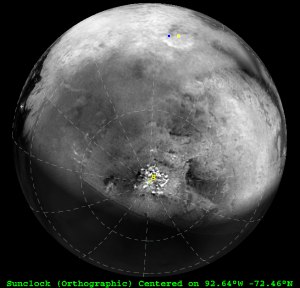Rev09 Non-Targeted Encounters

Graphic showing the geometry of Titan's surface features 9.5 hours before Closest approach during Monday's non-targeted flyby.
Cassini is now in its tenth orbit around Saturn, refered to within the project as Rev 09. You may recall that the first and second revolutions where replaced by three orbits (A, B, and C) thanks to the Huygens Doppler Shift correction. We are still within the ring occultation phase of the Cassini mission, so the satellites don't get much coverage during this orbit. There however will be a couple of important non-targeted opportunities during this revolution. First up will be Titan. On Monday, Cassini will come within a half a million kilometers of Titan, allowing for images with resolutions approaching 2.5 km/pixel, comparable to those taken during the last major non-targeted opportunity shortly after the Saturn Orbit Insertion burn (the encounter had been dubbed T0). Like that first encounter, this flyby will highlight the south polar region of Titan. Thanks to the northward climb of the sun in Titan's sky, this maybe one of our last best looks at this region. The last time we looked here, there was a field of convective cumulus clouds shrouding the south pole (as you can see in the graphic above which use a map that contains images that were taken on that flyby). Clouds, however, have been noticibly absent from Titan's skies for the last six months, and it is hoped by Titan surface scientists (like myself), that the south pole will remain cloud-free so that we can have at least one unobscured look at this region. After this flyby, there can be clouds galore. This flyby will also provide the best look thus far of the southern Xanadu region. The central and southern regions of Xanadu will be poorly covered during the Cassini nominal mission, so this maybe one of our best looks at this region for the entire mission.
The other non-targeted flyby on this orbit occurs after periapsis, on Thursday. The target this time will be the chaotic moon Hyperion. This will be our best look so far of this potato moon. A graphic showing the geometry of Hyperion near close approach is available. Cassini will come within 166,000 km of Hyperion early next Saturday, allowing for images with resolutions below 1 km/pixel. Such observations could be a tremendous boon for understanding Hyperion geology, spin state, and history, and will be a great primer for the targeted flyby of Hyperion in September. During that flyby, Cassini will come within 500 km of that satellite.
Other non-targeted encounters for this orbit include a 230,000 km encounter with Dione (which would show Dione's south polar region as well as Padua and Palantine Lineas).


0 Comments:
Post a Comment
<< Home